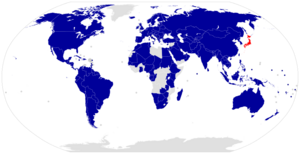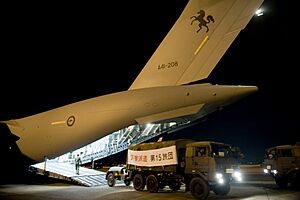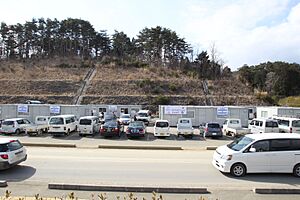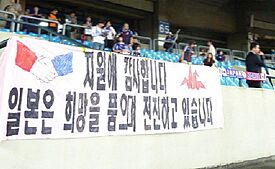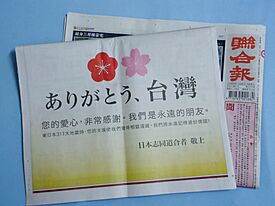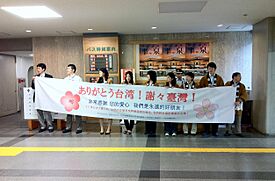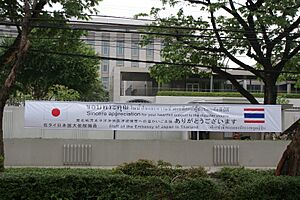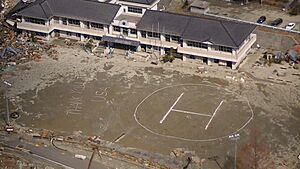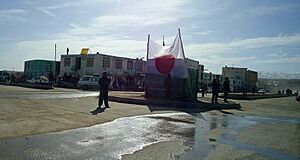Humanitarian response to the 2011 Tōhoku earthquake and tsunami facts for kids
In 2011, a very powerful earthquake and tsunami hit Japan. This natural disaster caused a lot of damage. After this event, many countries and organizations around the world quickly offered help. Japan's foreign ministry reported that 163 countries and 43 international groups offered support. The earthquake was incredibly strong, measured at 9.1 magnitude. This article shares how different governments and non-profit groups helped Japan during this difficult time. By March 2012, people had donated a huge amount of money, about 520 billion Japanese Yen, and nearly a million people volunteered to help with recovery.
Contents
How Japan Asked for Help
In the past, Japan sometimes had difficulties accepting help from other countries during disasters. However, after the 2011 earthquake and tsunami, things changed. The Japanese government quickly asked for international support.
On March 11, 2011, Japan's Foreign Ministry asked eight specific countries for help. These included South Korea, Singapore, Germany, Switzerland, the United States, China, the United Kingdom, and New Zealand. Japan also asked for satellite images of the affected areas. This helped rescue teams see where help was needed most.
Japan made it easier for foreign aid to arrive this time. They learned from past experiences and made rules more flexible. This helped rescue teams, medical supplies, and other important aid get to people faster.
Countries Around the World Sent Help
Many governments from all over the world quickly offered their support to Japan. Their help included rescue teams, medical supplies, food, water, and money.
 Australia sent a large team of 76 search and rescue experts. They also sent 20 tons of rescue equipment. The Royal Australian Air Force used large transport planes to bring supplies and equipment.
Australia sent a large team of 76 search and rescue experts. They also sent 20 tons of rescue equipment. The Royal Australian Air Force used large transport planes to bring supplies and equipment.
 Canada offered a team to help identify victims and equipment for chemical and biological safety. They also offered military planes, medical help, and engineering support. The Canadian Red Cross collected over $6 million in aid.
Canada offered a team to help identify victims and equipment for chemical and biological safety. They also offered military planes, medical help, and engineering support. The Canadian Red Cross collected over $6 million in aid. China sent a 15-member rescue team and pledged millions of dollars in humanitarian supplies. They also donated 20,000 tons of fuel. A special 62-meter water-pump arm was sent to help with the Fukushima nuclear plant.
China sent a 15-member rescue team and pledged millions of dollars in humanitarian supplies. They also donated 20,000 tons of fuel. A special 62-meter water-pump arm was sent to help with the Fukushima nuclear plant. France sent rescue teams with 134 members. They also shipped 130 tons of special robot equipment to help with the Fukushima nuclear accident.
France sent rescue teams with 134 members. They also shipped 130 tons of special robot equipment to help with the Fukushima nuclear accident. Germany sent search and rescue specialists. They also provided satellite images of the affected areas to help with planning.
Germany sent search and rescue specialists. They also provided satellite images of the affected areas to help with planning. India sent warm clothing and blankets. Their team also recovered and returned a large amount of cash to the authorities.
India sent warm clothing and blankets. Their team also recovered and returned a large amount of cash to the authorities. Israel sent aid organizations with first responders and medical staff. They even set up a field hospital near Minamisanriku, a town heavily affected by the disaster. This hospital included surgery, pediatric, and maternity wards.
Israel sent aid organizations with first responders and medical staff. They even set up a field hospital near Minamisanriku, a town heavily affected by the disaster. This hospital included surgery, pediatric, and maternity wards.
 Kuwait made a very large donation of $550 million in crude oil and other humanitarian supplies.
Kuwait made a very large donation of $550 million in crude oil and other humanitarian supplies. New Zealand sent an urban search and rescue team. These rescuers had just helped after an earthquake in Christchurch, New Zealand. They also sent 15 tons of rescue equipment and donated $2 million to the Japanese Red Cross.
New Zealand sent an urban search and rescue team. These rescuers had just helped after an earthquake in Christchurch, New Zealand. They also sent 15 tons of rescue equipment and donated $2 million to the Japanese Red Cross. Philippines The Philippine government offered rescue teams and a cargo plane. They also donated $10 million to Japan.
Philippines The Philippine government offered rescue teams and a cargo plane. They also donated $10 million to Japan.
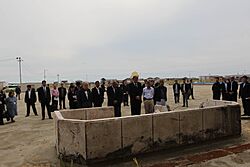
 Russia sent a large helicopter and a team of 50 rescuers. They also offered more aid and sent experts who had experience with the Chernobyl disaster.
Russia sent a large helicopter and a team of 50 rescuers. They also offered more aid and sent experts who had experience with the Chernobyl disaster. South Korea was one of the first countries to send emergency rescue teams, including rescue dogs. They also donated a lot of money, reaching $52 million by March 22. Korea also sent special materials to help with the nuclear reactions.
South Korea was one of the first countries to send emergency rescue teams, including rescue dogs. They also donated a lot of money, reaching $52 million by March 22. Korea also sent special materials to help with the nuclear reactions.
 Taiwan provided a huge amount of aid, over $252 million, making them one of the largest financial contributors. They sent rescue teams, generators, sleeping bags, food, and other daily necessities. Many Taiwanese people also visited Japan to show their support.
Taiwan provided a huge amount of aid, over $252 million, making them one of the largest financial contributors. They sent rescue teams, generators, sleeping bags, food, and other daily necessities. Many Taiwanese people also visited Japan to show their support.
 Thailand offered an initial $167,000 and later an additional $6.6 million. They also sent 15,000 tons of rice, canned food, blankets, and clothing. Search-and-rescue teams with sniffer dogs were also dispatched.
Thailand offered an initial $167,000 and later an additional $6.6 million. They also sent 15,000 tons of rice, canned food, blankets, and clothing. Search-and-rescue teams with sniffer dogs were also dispatched.
 United Kingdom sent 70 rescuers, including two search dogs, a medical support team, and 11 tons of specialized rescue equipment.
United Kingdom sent 70 rescuers, including two search dogs, a medical support team, and 11 tons of specialized rescue equipment. The United States launched "Operation Tomodachi" (meaning "friend" in Japanese). This involved military forces, including a carrier group and air base personnel. They helped restore the damaged Sendai Airport and sent urban search and rescue teams.
The United States launched "Operation Tomodachi" (meaning "friend" in Japanese). This involved military forces, including a carrier group and air base personnel. They helped restore the damaged Sendai Airport and sent urban search and rescue teams.
Help from Non-Profit Groups and Individuals
Besides governments, many non-profit organizations and individuals also stepped up to help Japan.
- In the United States, individuals, groups, and companies donated at least $746 million. This was one of the largest amounts ever given by Americans for an overseas disaster.
- The Soka Gakkai organization used its facilities as shelters and places to distribute supplies. They also raised money worldwide and offered emotional support.
- A fundraising concert in Taiwan with 300 singers and celebrities raised $26 million for Japan.
- The Roman Catholic Church offered prayers and large donations from churches and the Vatican.
- Organizations like The Church of Jesus Christ of Latter-day Saints provided financial help and equipment to Japanese fishermen.
- Samaritan's Purse sent a disaster relief team to Japan with supplies.
- The Canadian Red Cross and other groups collected funds from citizens.
- The Philippine National Red Cross raised over $1.6 million in donations.
- In South Korea, groups like the Korean Disaster Relief Association and UNICEF collected donations. Companies like Samsung Group also donated millions.
- Charities in Hong Kong, such as The Salvation Army and Hong Kong Red Cross, accepted donations.
- In Thailand, many fundraising campaigns were held through TV, mobile phones, and charities like the Thai Red Cross.
- Many NGOs in the United States, like the American Red Cross and The Salvation Army, launched mobile donation efforts.
- ShelterBox, a disaster relief charity, provided emergency shelters for nearly 1600 families. They could provide even more if needed.
- World Vision Japan worked with Delta Air Lines to transport aid workers and supplies. They focused on providing essential items and creating safe spaces for children.
- Mercy Corps partnered with a local Japanese organization, Peace Winds Japan, to bring relief to survivors. They provided tents, blankets, food, and school supplies. Later, they helped with economic recovery and emotional support.
- The music industry's four biggest record labels (EMI, Sony, Universal, and Warner) worked together to create an album called Songs for Japan. All the money from this album went to the Japanese Red Cross Society.
- The rock band Linkin Park's charity, Music for Relief, released an album called Download to Donate: Tsunami Relief. The money went to Save the Children for the victims.
- Players of the video game Team Fortress 2 donated over $430,000 through an in-game item sale.
- ChildFund Japan distributed emergency supplies like masks, diapers, and food to evacuation centers.
- A group of Scottish Whisky Distilleries created a special whisky called "Spirit of Unity" and donated all profits to relief efforts.
- The Japanese Federation of the Deaf and Disabled Persons International helped people with special needs.
- Japanese professional wrestling promotions like All Japan Pro Wrestling and New Japan Pro-Wrestling held charity events called All Together, raising hundreds of thousands of dollars.
- Riot Games, the creator of League of Legends, donated $160,000 from a special sale of a character inspired by Japanese culture.
More to Explore
- Songs for Japan (a music album created to raise money for relief efforts)
- Yuzuru Hanyu Notte Stellata (an ice show that raises funds for disaster-affected areas)



